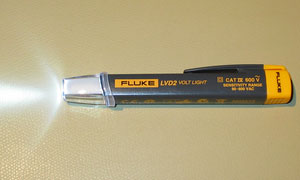Difference between revisions of "Non-contact Volt stick"
m (NT moved page Voltstick to Non-contact Volt stick) |
|||
| Line 11: | Line 11: | ||
The other issue with these is that they sometimes see a dead cable as live due to stray capacitance coupling. So they're fast but their results not to be relied on. | The other issue with these is that they sometimes see a dead cable as live due to stray capacitance coupling. So they're fast but their results not to be relied on. | ||
| + | |||
| + | There are also direct contact voltage measuring sticks. | ||
| + | |||
Latest revision as of 23:28, 3 December 2017
These can detect whether wires are live or not without contacting the conductor, they are just held against the insulated wire. They make fault finding a quick easy process in some cases.
They don't have the direct shock risk of Neon screwdrivers but suffer false negatives and false positives, so can fail to indicate a live circuit. This is of course a shock risk.
They are useful as they're fast, since no conductor need be bared to take a reading. But relying on them before touching a potentially live wire is not recommended, and not legal in a work setting.
They work by detecting the voltage difference between a plate or tip at the probing end and the user's hand. They operate at extremely high resistance, enabling them to detect the capacitively coupled stray electric field. One problem is that the user is sometimes be capacitively coupled to a live wire, eg due to leaning on a wall where a buried cable runs. In this situation the volt stick gives the opposite results, ie it sees no voltage difference on a live cable, but sees a voltage difference with a dead cable.
The other issue with these is that they sometimes see a dead cable as live due to stray capacitance coupling. So they're fast but their results not to be relied on.
There are also direct contact voltage measuring sticks.
A multimeter or voltmeter can will do far more than a neon screwdriver, and do so with more reliable results. Multimeters have their own safety issues, but they are much less and more under the control of the end user, so can be minimised with care.
